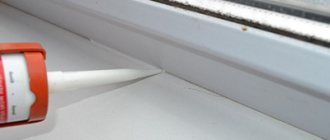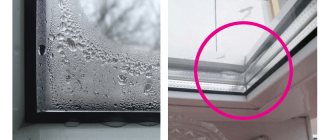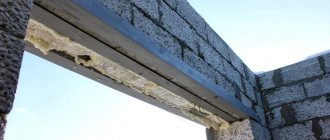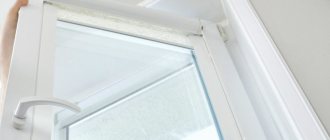By installing new plastic windows indoors, their owners expect to once and for all resolve issues related to maintaining the optimal temperature and desired microclimate inside. However, their hopes are rarely fully justified, because modern PVC structures can also present unpleasant surprises. The most common problem is the following: it is blowing from a plastic window. Moreover, the drawback occurs not only in newly installed structures, but also appears in proven windows that have been in use for several years. What are the causes of this trouble and how difficult is it to get rid of it? We will try to give answers to these questions in this article.
How to understand where it's blowing from?
Cold air can enter the apartment in the following ways:
- through the gap between the wall and the window frame;
- through the hole between the window frame and the sash;
- through the gap under the window sill;
- through micro-slits along the perimeter of the frame.
Sometimes it can come through literally from everywhere. To quickly find out exactly how cold air gets into your apartment, just run your hand along the slopes, window sill, frame. To increase sensitivity, you can pre-wet your hand. It is advisable to conduct the experiment in windy weather or when there is a large difference in temperature outside the window and in the apartment. The flame of a candle, match or lighter can also tell you where the wind is blowing - in such places it will deviate from the vertical position, but you should be extremely careful with fire, first removing all curtains and other objects that can easily catch fire.
If you suspect that the seal does not fit tightly, then you should outline it with chalk and close and open the window several times. By the absence of traces of chalk, you can understand where the seal fits poorly.
A special case
The window is sealed, but it still blows.
Perhaps the apartment has too much forced ventilation, for example, an exhaust hood in the kitchen or bathroom.
By pumping air out of the apartment, it creates a vacuum, and due to the difference in pressure inside the house and outside, air will be sucked into the apartment through micro-holes in the places where handles and fittings are attached.
In this case, you need to adjust the pressure in the apartment (install check valves on the hood).
Blowing from plastic windows
With the onset of cold weather, many owners of plastic windows discover drafts and blowing. And this problem is relevant not only for old windows, but also for those that were installed more recently.
There can be quite a lot of reasons. And the problem does not always lie in the design itself. Let's look at how to tighten plastic windows so that it doesn't blow, and why a draft can appear in general.
Reasons for blowing plastic windows
Why can plastic windows, which are so praised for their tightness, let in cold air? Where do these very cracks come from? Plenty of reasons:
- The installation technology is broken. Nowadays in large cities the competition is so high that it is difficult to find a contractor who violates installation technology. About 15-20 years ago everything was different, then the demand for windows was huge, and the workers often did not have enough qualifications. This problem still occurs in some remote regions of the country. For example, installers may have used insufficient foam, foamed in one step, failed to remove dust before foaming, or failed to protect the outer layer of foam from the sun. Perhaps the slopes were not insulated or the required distance between the wall and the window block was not maintained. The list of reasons can be continued for a long time.
- Shrinkage of the building. All new buildings shrink, and if the windows are installed with sufficient clearance at the top, then there should not be any special problems, but misalignment often occurs.
- Incorrect operation. If the seal is not lubricated, it quickly dries out and begins to leak air. If you do not change the mode from winter to summer and vice versa, the seals and fittings will fail faster. If the sash sags, it is necessary to adjust the fittings. If you don’t do all this, then don’t be surprised that it starts to show through.
- Low quality profile, seal, fittings. Everything is clear here without further ado.
- Natural wear and tear . First the seals “die”, then the trunnions. These elements need timely replacement.
Often it is not possible to figure out the reasons on your own, so it is better to call reliable specialists who will repair plastic windows properly. In Moscow, you can contact “Moscow Window Service”: craftsmen come to the site with everything necessary for repairs, carry out work in accordance with GOST, sign an agreement, and after that you can leave a review, which will be read personally by the director of the company. The website has a price list and a calculator for calculating the cost of work. Everything is fair and transparent.
If you have any skills in repairing and maintaining windows, then you can try to do it yourself. Some things are easy to do yourself, especially if the profile and fittings are of high quality, and the installation was correct.
Technological progress in the 21st century is demonstrating unprecedented growth rates. We are learning to control computers with our thoughts, and we are seriously preparing to land on Mars. In the meantime, the spaceships are, so to speak, plying around - we seal the plastic windows for the winter, the old fashioned way...
Despite all the promises, it blows through plastic windows, sometimes no less than through old wooden ones. And it’s not surprising - the years go by, and the quality of new window designs only decreases.
In this article, I will try, if possible, to consider all the main causes of this problem, and give recommendations for eliminating them. But you won’t find a magic adjustment key with which you can get rid of drafts once and for all. I think that I will not reveal a big secret if I say that numerous “instructions for switching windows to winter mode” wander from site to site only to attract attention to advertising.
However, if you make the correct diagnosis, you can really completely get rid of blowing windows.
And, I note, you can save a lot of money at the same time...
For convenience, we will divide the “culprits” of the malfunction into groups.
I. Seal
II. Accessories
III. Errors when glazing a window
IV. Design defect
V. Installation
VI. Technological and externally introduced blowing
VII. Pseudo-blowing (convection)
I. Reasons for blowing out a plastic window - problems with the seal
Let's start with the sealing rubber of windows - and not at all because the main reasons for their blowing are associated with it (far from it, no), but simply because rubber is always “heard of.” In the window business, the words “blows” and “seal”, thanks to the aggressive marketing policies of various sellers of repair services, have become practically synonymous - to be convinced of this, just type them in the search. After all, replacing a rubber seal is relatively simple, does not require too much experience, and at the same time, a very profitable business!
But, of course, there are real reasons for plastic windows blowing out “due to rubber”, and they are as follows:
1) A seal that has served for 10 years or more, as a rule, is no longer able to effectively perform its functions. Aging occurs faster if the window is on the sunny side.
2) Cement dust and whitewash, during painting and plastering work, can very quickly dry out and “age” the rubber. It becomes flattened, hard, and the window begins to blow. If you lubricate the seal with silicone oil after repairs, you can try to restore its properties, but it is much better to prevent such a development and seal the windows with plastic film in advance, before starting work.
3) The seal becomes unusable ahead of schedule due to installers adjusting the windows “for winter mode” - if this is done immediately, directly during their installation. Rubber compressed to the limit can very quickly, literally within a few years, completely lose its elasticity.
4) The seal, which was tightly tensioned at the factory (read: short), “comes off” from the corners of the sash, and blows into the resulting cracks.
5) Sometimes, on the contrary, there is too much rubber, and it forms a “wave”. When blowing through a plastic window, dust falls along the frame in a “dotted line.”
6) Rubber, for various reasons, can fall out of its groove. Especially often it gets knocked down on the lower part of the frame of balcony doors.
7) The seal diverges at the joint - usually above the sash (again, if it is too short). There is noticeable blowing from the rubber joint, however, only if the technology is violated - if the joint is made not from above, but from below.
Colored seals (white, gray), for the most part, are much tougher than black ones in the cold season; plastic windows with them are blown out much more often. Such a design may backfire on you in the coming winter.
9) The same applies to plastic windows with a co-extruded seal - when the rubber is pre-fused into the plastic profile. Such windows cost the manufacturer less than traditional ones, although they themselves can be positioned as elite. They can be distinguished from ordinary ones by the appearance of the corners of the sash (and, if processed poorly, there is constant air blowing through the corners). Since the seal of such windows is, in fact, the same plastic (and not rubber), its elasticity sharply decreases in winter.
10) If your windows were installed for free (during a major renovation, or in a new building), then it is possible that part of the seal was simply cut out. This is done to ensure that the double-glazed windows comply with SNiPs for air exchange. As they say, with one hand you heal, with the other you cripple - air exchange in the room is certainly necessary. But in this case, it is completely uncontrollable, since these are just holes - in contrast to the correct supply valves with the ability to adjust.
11) In new houses, after residents complain about plastic windows blowing, developers sometimes change the tires themselves. At the same time, they try to use the one that is thicker - most often, they install a glass seal instead of a sash one. As a result, it becomes very difficult to close the handle completely, and it begins to blow even stronger.
What can be done in most of these cases?
Adjusting the pressure of a window with an old seal or one damaged during repair can only slightly delay the time for its replacement. It is better to replace short and deformed rubber with new, colored and co-extruded (if technically possible) - with regular, black EPDM. And, of course, the seal must correspond to the profile system (be “original” or its equivalent), and not a universal “noodle” that some would-be repairmen will be happy to “hang on your ears.”
II. Fittings and blowing of plastic windows
Adjusting the fittings is the next most popular way to eliminate blowing from windows, after replacing the seals. Why doesn’t he always help, even if for this purpose a “master” was called in, who spent half a day turning the pins and window hinges with a wrench?
12) The hooks may be installed too far from the locking pins of the fittings. In this case, when you turn the handle, the window sash is poorly pressed against the frame, and it blows from under it. The distance from the bar to the trunnion, in the “open” position, should be no more than 3-5 mm.
13) Sometimes strikers are simply missing - they are forgotten to be installed at the factory, or they may be positioned completely incorrectly. Blowing through the plastic window, in this case, is inevitable.
14) The window mechanism can be inexpensive, of a simplified type - a short main lock on the swing sash, a short middle lock (between the hinges) on the tilt-and-turn sash, too large a distance between the trunnions. There may be no clamps on the bottom and top of wide sashes, or side clamps on rotary sashes.
15) An error when installing the lower hinge on the sash (its displacement) leads to blowing in the corresponding corner of the plastic window. The same applies to the positioning of the middle pressure (between the loops).
16) Rotating and loosening the screws securing the fittings, for example, when using metal screws for plastic. In this case, very little force is enough to “break the thread.” Usually the strikers of such windows are loose and do not hold well in the groove.
17) There are cases when, in new buildings, fittings are removed from temporarily “unattended” windows, replacing them with those who have already moved in.
18) Various breakdowns of the mechanism, in the cold season, also lead to the window blowing out.
“Twisting the loops” in all these cases is practically useless.
The correct way to eliminate the blowing of plastic windows is to install the strikers in their places, repair, modernize or replace parts of the fittings. Before doing this, you should make sure that the window sash is not skewed (see below).
III. Errors when glazing a window
Glazing “jambs” are the lion’s share of the real reasons for blowing. Without eliminating them, all other measures are usually ineffective.
It would seem, what is the connection between glass and blowing from a plastic window? And it is the most straight one - it is the glass that is the load-bearing element that gives the sash its rectangular shape.
19) The double-glazed window does not stretch the sash diagonally, since the adjustment and support plates inside (between the plastic and the glass) are located incorrectly, are not selected in thickness, or are missing. As a result, the sash “sags” (one of the corners hangs lower than the other), and it warps. A gap appears at the top, and the pressure on the side worsens, since the locking pins “go” below the counter strips. As a result, the plastic window blows air from several sides at once.
20) High sashes are not wedged from the inside, with additional plates “in the center,” and the profile bends. Usually, in this case, the plastic window blows from the side of the hinges, and/or near the handle.
In my opinion, these two points are the reason for the vast majority of cases of strong wind blowing through windows.
Treatment is adjustment “according to geometry”, or re-glazing of the window. It is done by a competent craftsman (and not a loop twister), only once for the entire life of its service.
IV. Defect in the production of the window (its plastic part)
This, unfortunately, happens. The human factor always exists, and besides, the wages of window structure assemblers, as a rule, directly depend on the number of “square meters” produced per shift.
Here are the main production costs that can cause windows to blow out:
21) Mismatch between the geometric dimensions of the frame and sash. The error is only a couple of millimeters, enough for the window to blow.
22) Vertical imposts (lintels) are installed with a sideways offset, which causes interference on one of the adjacent sashes and blowing on the other.
23) The imposts are not tightly screwed to the frame, resulting in the formation of cracks into which it blows. The same phenomenon is observed when glazing beads are too long (for example, very often, at balcony doors).
24) The glazing beads, on the contrary, are sawn off too short or crooked - after installing the window, there is air in the gaps between them.
25) The window profile is not reinforced, or the reinforcement metal inside is too thin. Due to the general economy, the latter is found everywhere, since it is impossible to see the “hackwork” without sawing the window. Leads to deformation of the sash and blowing of the plastic window.
26) Poor mechanical processing (cleaning) of plastic - because of this, burrs are formed, and the seal is wrinkled or does not hold in the corners. For windows with co-extruded rubber, the fusion at its junction is often not removed, which prevents the sash from being tightly pressed to the frame.
If the warranty on the windows has already expired, manufacturing defects have to be eliminated using improvised means.
It all depends on the experience and qualifications of the master. In addition to direct hands and knowledge, in severe cases, sealant, a new seal of a different type, etc. can sometimes help combat the blowing of plastic windows.
V. Installation defect
But, alas, it occurs much more often than we would like. The reason is a huge turnover of personnel in the position of installer, hence the many untrained “masters” who are abandoned. Often, windows in new buildings, and so-called municipal ones (replaced free of charge by the city during major renovations), are installed by ordinary laborers who just yesterday were sweeping the floors and painting the walls.
So, the main installation defects:
27) Classic - poorly foamed frames. It blows air around the perimeter of windows, from the joints of windows with plastic slopes, from under slopes, and window sills.
28) The window frame is stretched “barrel”. In this case, the fittings on the side of the sash do not engage, so they blow between the hinges and near the handle (more often on balcony blocks). Easily diagnosed by measuring the inside width of the frame with a tape measure, first in the center, then at the top or bottom. If the difference is more than 2-3 mm, the plastic window can already blow.
29) The window frame is heavily “cluttered” - skewed diagonally. In this case, an effect similar to sagging of the sash occurs - it blows from above, below or from the side. If there are several sashes, a significant difference in height at their adjacent corners is visible to the naked eye.
30) The strikers were moved/removed by installers who are unable/unwilling to adjust the windows. In this case, the plastic window blows out due to the fact that the pressure of the frame to the sash sharply deteriorates, or in some places is completely absent.
Blowing through windows from joints and seams can be treated by reinstalling them , or, as a last resort, using high-quality sealant (if the slopes are plastic and the wind is blowing moderately).
In case of distortions and deflection of the frame “barrel”, instead of reinstallation, it is easier to adjust the sashes according to the geometry. The shape of the sash is made to match the shape of the frame, which is practically unnoticeable, there is no need to break the slopes , and the blowing stops completely. But for this you need an experienced master in this particular type of adjustment.
VI. Technological and external window ventilation
31) Blowing from the top hinges of plastic windows. This is a completely normal phenomenon and usually cannot affect the overall temperature in the room. It’s another matter if there are no radiators under the windows, or the ventilation in the house is excessively powerful. In these cases, you should not sit with your back to the window in winter, or set up a workplace near it.
32) Blowing out window handles. It is not noticeable at all under normal conditions, except for small traces of dust on the sides of the handle.
33) Deformation of the seal by fastening blinds, or wires of external antennas and thermometers. It blows precisely in the places where the seal is bent. You should choose roller blinds and blinds that are fastened with self-tapping screws on the plane of the sash, and not with “hooks” on its edges (although such products are easier to install).
VII. Convection currents of cold air, or apparent blowing through the window.
Yes, yes, sometimes a completely sealed and even blind (without opening) window can “blow” in winter.
34) In the absence of heating devices directly under the window units - in winter, it is uncomfortable to be near the windows. Everything is simple here - a double-glazed window is, as a rule, colder than a solid wall, and cold air is heavier than warm air. It “flows” down along the glass, creating the impression of blowing , even if such a window is completely blank. This “pseudo-blowing” effect can be easily felt by simply opening a working refrigerator, from which, as you understand, there is no way to blow. Therefore, no matter how good the windows are, there is always a “blow” on unheated loggias. And here you can’t get away with a warm floor, the radiator must be located directly under the windows, creating a thermal curtain, just as it is done in the rooms, and the walls must be very well insulated.
35) In the case of a very large glazing area (wall-to-wall windows), the battery is of insufficient power or width; in cold weather it simply cannot cope with the cold convection flow.
36) The “blowing” effect can also be noticeable if the radiators are covered with wide window sills, curtains, or decorative panels. Flowers often freeze on such window sills in winter, and sometimes ice forms on the glass. And windows, as a rule, have nothing to do with it!
Summary
It is important to understand that all of the above reasons for blowing windows can occur either individually or together with each other. Therefore, you shouldn’t try to “tweak the fittings” right away, or what’s worse, throw away a lot of money on replacing a completely “living” seal. It is better to invite an experienced, trusted technician to diagnose and then competently adjust or repair (upgrade) the windows.
No. 1. Tighten fittings
Eccentrics are responsible for the tightness of pressing the sash to the window frame. The eccentric has three positions: summer, winter and neutral. During installation, it is left in a neutral position, but this pressure is not enough when it is cold or strong wind outside.
The neutral position of the trunnion is when the risk point on it is located along the vertical axis. switch it to the winter position by turning the eccentric of the trunnion so that the risk points towards the rubber band. This ensures the best possible pressure. Adjustment can be made using a hex wrench. Summer position – the risk is facing the street. By switching windows to summer mode, you can extend the life of the seal.
Cover with sealant
This method is suitable if the gap between the window sill and the window frame is not very large . In addition, compared to other methods of combating drafts, this is the cheapest.
Defects are eliminated using a transparent sealant. Before using it, the gap should be cleaned of dust and dirt, degreased, and dried.
The gap between the frame and the window sill must be cleaned of dirt
Then, using the tube nozzle, apply the maximum possible amount of the substance until it is completely filled.
For the easiest way to eliminate a defect, use a sealant
To get a beautiful seam, run the edge of a 10-ruble coin along it. Do this in a continuous motion to avoid crooked seams.
The advantage of this method is that all the work takes a matter of minutes. Disadvantage: fragility. After two years, the sealant begins to peel off and darken.
No. 2. Sash adjustment
Frequently opening the sash wide open can cause it to sag or sag. If the sash is sagging , the order of work is as follows:
- remove the decorative caps and open the sash;
- take a furniture key and turn the screw in the top hinge clockwise, then the vertical screw in the bottom hinge. Each time, rotate 180 degrees and check how the sash is pressed;
- if it is not possible to achieve the ideal geometry, it is necessary to tighten the horizontally located screw;
- return the decorative caps to their place.
If the sash has sagged , then you need to work with the lower hinge, tightening the vertical screw there.
Marriage
How to insure against marriage? Is it possible?
Certainly! If you order window installation from a reliable company. For example, for Okna-Teplo, a reputation that has been earned over the years is extremely important. We install windows only from trusted manufacturers, and if anything happens they are covered by a warranty.
When the reason for the window blowing is the fittings, clients often come to us with similar questions - “Why is there blowing from the handles of plastic windows?”
It will be possible to say exactly what exactly caused the blowing only after dismantling and disassembling the window sash.
Of course, we do not recommend that our clients turn to “specialists” in their neighborhood for help in this matter. The fact is that the desire to save quite often leads to double spending.
No. 3. Replacing the seal
A good seal will last 15 years if properly cared for. It may fail even earlier. You can do the replacement yourself, but note that you need to change two sealing circuits at once - on the sash and the frame. The progress of work is as follows :
- close the window, remove the protective panels from the hinges, squeeze the pin out of the upper hinge, the sash rises and moves out of the lower hinge;
- use a spatula, screwdriver or knife to pry up the old seal and pull it out of the grooves;
- thoroughly clean the places where the seal is attached, dry, then degrease with white spirit or acetone;
- cut the new seal into pieces of the required length, and it is better to do this with a margin of 5 cm;
- It is better to start attaching the seal to the frame from the corner, on the sash - in the middle, from the side of the hinges;
- It is better to secure the end of the seal with glue to make it more convenient to work. The cord is tucked into the groove without tension; you can additionally roll it with a roller. It is better to also glue the second end to the groove, cut off the excess;
- put the sash in place and, if necessary, readjust the fittings.
What to do if a plastic window is blowing from below from under the sash
If the adjustments described above did not resolve the problem, it means that the rubber seal is worn out. In this case, you can see the following defects: rubbing, jamming, loss of elasticity. We select new tires according to the sample or type of profile system. We change in the following sequence:
- Use the handle to open the door.
- In the corner we pry up the seal and tighten it around the perimeter until we reach the top loop.
- We move the sash to the “ventilation” position.
- We take out the remaining part of the sealing rubber.
- Carefully clean and wash the installation groove.
- We place the beginning of the new rubber at the top in the middle. We completely go around the perimeter with a single contour. It is important to avoid excessive tension at the corners.
- At the junction we cut the rubber without excessive tension or overlap.
- Pull out both ends of the elastic. Apply a drop of Moment glue to their lower parts and install them back.
Be sure to change the second sealing contour, which is located on the frame. The principle of operation remains the same.
The described method is suitable for tilt and turn opening. To repair conventional pivot windows, you must first remove the sash.
No. 4. Pressure restoration
A common problem with tilting windows is the wear of the scissors, as a result of which the corner of the sash begins to move away from the frame, letting in cold air. It's easy to fix the situation:
- open the door;
- turn the handle of the open sash upward (as if for ventilation), the sash will recline;
- there will be an adjustment screw on the scissors, which must be turned clockwise 180 degrees, then close the sash, put the handle in a horizontal position, press the window to the frame and close. If there is leakage, repeat the operation by turning the screw another 180 degrees, and so on until complete tightness is achieved.
Incorrectly selected double-glazed windows
We have installed plastic windows for you. Why does the wind blow?
There is a possibility that this is an illusion. No, you can actually feel the movement of air masses that appears as a result of the collision of cold air and warm air. But in reality there is no breeze from the windows.
Perhaps the company that dealt with your windows selected the wrong double-glazed windows. As a result, the glass does not have time to warm up with heating radiators, as it quickly loses heat.
If you bring your hand close to such cold glass, you may feel as if it is blowing from the window.
No. 5. Window sill insulation
The place under the window sill is very often the weakest link; there you can find construction waste, cement, and pieces of brick. Sometimes the entire space is filled with polyurethane foam, but this is not the best option, since it can shrink. In short, without proper insulation, the cold will continue to enter the house. To block his path, you should:
- peel off the wallpaper under the window sill, remove the plaster, remove the old foam, pull the window sill panel towards you;
- clear the space of debris, old foam, seal the cracks with foam, install the window sill correctly;
- plaster the walls and return the wallpaper to its place.
No. 6. Insulation of slopes
Incorrectly insulated or non-insulated slopes are simply gates for cold air. Insulation work consists of the following:
- remove slopes, and plastic ones can be dismantled carefully without destroying them, but plasterboard ones will have to be broken;
- remove the insulation if it is present (you can often find insulation with polyurethane foam or fiberglass, which do not cope with their tasks very well);
- plaster the wall, treat everything with an antiseptic to prevent mold from growing;
- insulate the slope. Ideally - basalt wool, but polystyrene foam is also possible;
- install the slope.
Insulation of the slopes may also be necessary from the outside , and if the polyurethane foam was not protected by anything, then this operation is generally worth starting with. It is necessary to remove the old foam, thoroughly clean the gap and foam it again, not forgetting to install a cover that will protect the foam from the sun that is destructive to it.
Difficulties and errors
Lack of experience can lead to problems when eliminating drafts of plastic windows. In order not to completely break the structure, there is no need to rush. A competent approach to repairs, studying instructions from various sources, consulting with a specialist will help you cope with minor repairs yourself.
A common mistake made by novice craftsmen is incorrectly determining the location of the blower. As a result, the sealed area is dismantled, and the problem area remains without repair.











